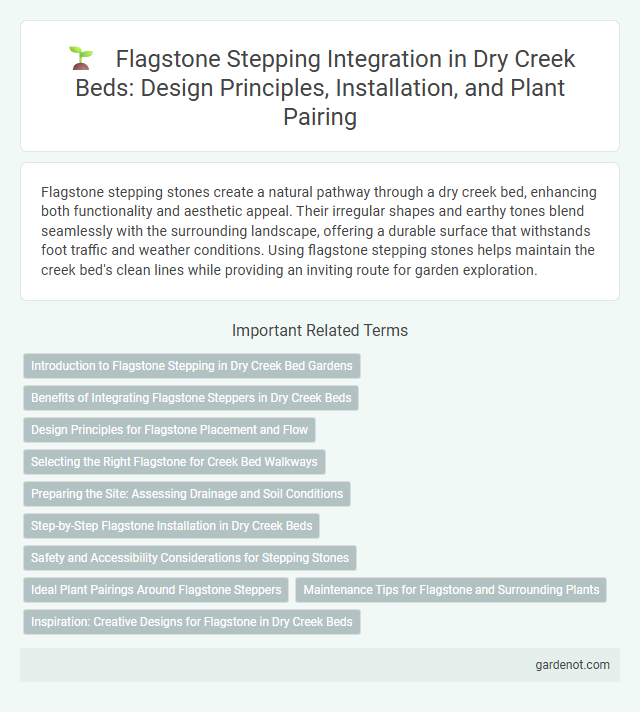Flagstone stepping stones create a natural pathway through a dry creek bed, enhancing both functionality and aesthetic appeal. Their irregular shapes and earthy tones blend seamlessly with the surrounding landscape, offering a durable surface that withstands foot traffic and weather conditions. Using flagstone stepping stones helps maintain the creek bed's clean lines while providing an inviting route for garden exploration.
Introduction to Flagstone Stepping in Dry Creek Bed Gardens
Flagstone stepping in dry creek bed gardens provides durable, natural-looking pathways that enhance landscape aesthetics while promoting water drainage. These flat, irregularly shaped stones create stable walking surfaces that blend seamlessly with the organic contours of dry creek beds. Incorporating flagstone steps helps prevent soil erosion and supports sustainable garden design by channeling rainwater effectively.
Benefits of Integrating Flagstone Steppers in Dry Creek Beds
Flagstone steppers in dry creek beds provide durable, slip-resistant surfaces that enhance safety while seamlessly blending with natural surroundings. Their porous texture allows water to drain efficiently, preventing erosion and maintaining the creek bed's structural integrity. Incorporating flagstone steppers also adds aesthetic appeal, creating natural pathways that complement xeriscaping and low-maintenance garden designs.
Design Principles for Flagstone Placement and Flow
Strategic flagstone stepping in a dry creek bed enhances natural flow and visual appeal by following the contour lines and varying stone sizes to mimic organic patterns. Proper spacing between stones ensures safe footing while maintaining the illusion of a natural water path. Incorporating irregular shapes and textures promotes a seamless integration with surrounding landscapes, supporting erosion control and aesthetic harmony.
Selecting the Right Flagstone for Creek Bed Walkways
Selecting the right flagstone for dry creek bed walkways involves choosing stones with natural textures and varied shapes to enhance aesthetic appeal and ensure slip resistance. Opt for durable materials like sandstone, slate, or bluestone, which withstand weather conditions and provide long-lasting stability. Properly sized flagstones, typically between 12 to 24 inches, facilitate easy installation and create a comfortable walking surface.
Preparing the Site: Assessing Drainage and Soil Conditions
Assessing drainage and soil conditions is crucial when preparing a dry creek bed for flagstone stepping installation. Proper evaluation ensures water runoff is managed effectively, preventing erosion and pooling around the stones. Testing soil composition helps determine if amendments or a gravel base are needed to provide stability and promote longevity of the flagstone pathway.
Step-by-Step Flagstone Installation in Dry Creek Beds
Flagstone stepping in dry creek beds involves careful site preparation by clearing debris and leveling the area to ensure stable placement. Each flagstone should be set on a compacted base of sand or gravel to promote drainage and prevent shifting over time. Proper spacing between stones allows for natural water flow and supports the aesthetic continuity of the dry creek bed landscape.
Safety and Accessibility Considerations for Stepping Stones
Flagstone stepping stones in a dry creek bed enhance safety by providing stable, non-slip surfaces that reduce the risk of falls, especially in wet conditions. Proper spacing and size ensure accessibility for people of varying mobility levels, including those with limited balance or using assistive devices. Incorporating textured surfaces and even placement further improves traction and ease of navigation along the pathway.
Ideal Plant Pairings Around Flagstone Steppers
Ideal plant pairings around flagstone steppers in a dry creek bed include drought-tolerant species such as lavender, sedum, and ornamental grasses like blue fescue. These plants thrive in well-drained soils, complementing the natural stone's textures while providing visual interest and seasonal color. Incorporating native wildflowers and succulents enhances ecological balance and requires minimal maintenance, perfect for sustainable landscaping.
Maintenance Tips for Flagstone and Surrounding Plants
Regularly sweep and rinse flagstone to prevent dirt buildup and moss growth, preserving its natural texture and color. Trim surrounding plants to avoid root intrusion that can cause shifting or cracks in the stones. Apply a breathable sealant annually to protect against weather damage while allowing moisture to escape, ensuring long-term durability.
Inspiration: Creative Designs for Flagstone in Dry Creek Beds
Flagstone stepping stones transform dry creek beds into artistic pathways, enhancing both aesthetic appeal and functionality. Incorporating irregular shapes and natural hues of flagstone creates a seamless blend with the rugged landscape, inspiring unique garden designs that echo natural watercourses. Creative patterns and spacing ideas introduce texture and depth, making dry creek beds a focal point in outdoor spaces.
Flagstone stepping Infographic

 gardenot.com
gardenot.com